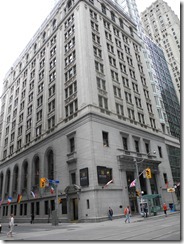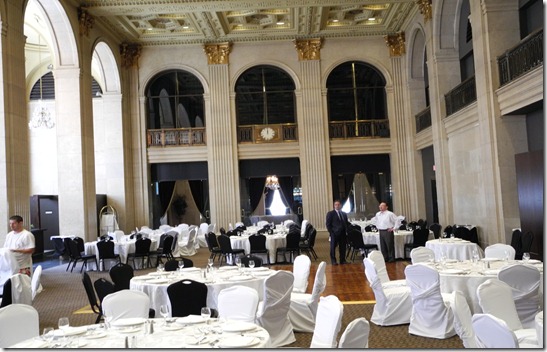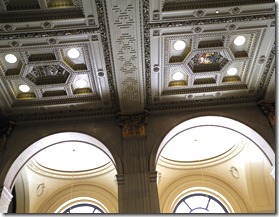As a teenager, I was employed by the Dominion Bank for two summers. It was in the days prior to its merger in 1955 with the Bank of Toronto, when it became the Toronto-Dominion Bank (TD Bank). I worked at the Dominion Bank at Bloor St. and Dovercourt Road, and another summer at the branch at Bloor and Bathurst Streets. Both these branches are no longer in operation. I delivered bank drafts to customers within walking distance of the bank and handled the cash book, which recorded the daily transactions of the tellers. Balancing the book was a real challenge for me. My only help was an adding machine. On Friday evenings, when the bank was crammed with customers, I wrote up the pass books (bank books), with a fountain pen, entering the amount of the withdrawals and deposits and calculating the new balance. No adding machine was available for this endeavour.
Because of my teenage experiences, it was with great interest that I visited the old Dominion Bank building during this year’s “Doors Open Toronto” program. Located at One King Street West, the 12-storey skyscraper was erected in 1914, the year the First World War began. Built in the Beaux-Arts style, it was designed by the firm of Darling and Pearson, with the co-operation of the engineering company of Harkness and Oxley. Many of the head office activities of the bank were located within the building. The Grand Banking Hall, 154 feet long and 68 feet wide, contains Corinthian pilasters (faux columns) and features Travertine marble throughout the space. Its 45-foot ceiling has a gold-leaf coffered design that features the emblems of Canada’s nine provinces. The crest of Newfoundland is missing as it did not join the Confederation until 1949. The original 100-foot tellers’ counter is now a bar, the longest in the nation. A branch remained on the premises until the year 2000. In 2005, the building was sold for residential use, and was redesigned for this purpose by the architect Stanford Downey. It is presently one of the most prestigious condo-residences in the city.
The Grand Banking Hall is today a restaurant. Its Corinthian pilasters are evident in this photo.
Coffered ceiling with the gold-leaf designs that depict the provincial emblems of Canada’s original nine provinces.
To view the Home Page for this blog: https://tayloronhistory.com/
To view previous posts about movie houses of Toronto—old and new
https://tayloronhistory.com/2013/10/09/links-to-toronto-old-movie-housestayloronhistory-com/
To view links to other posts placed on this blog about the history of Toronto and its heritage buildings:
https://tayloronhistory.com/2013/10/08/links-to-historic-architecture-of-torontotayloronhistory-com/
Recent publication entitled “Toronto’s Theatres and the Golden Age of the Silver Screen,” by the author of this blog. The publication explores 50 of Toronto’s old theatres and contains over 80 archival photographs of the facades, marquees and interiors of the theatres. It also relates anecdotes and stories from those who experienced these grand old movie houses.
To place an order for this book:
Theatres Included in the Book
Chapter One – The Early Years—Nickelodeons and the First Theatres in Toronto
Theatorium (Red Mill) Theatre—Toronto’s First Movie Experience and First Permanent Movie Theatre, Auditorium (Avenue, PIckford), Colonial Theatre (the Bay), thePhotodome, Revue Theatre, Picture Palace (Royal George), Big Nickel (National, Rio), Madison Theatre (Midtown, Capri, Eden, Bloor Cinema, Bloor Street Hot Docs), Theatre Without a Name (Pastime, Prince Edward, Fox)
Chapter Two – The Great Movie Palaces – The End of the Nickelodeons
Loew’s Yonge Street (Elgin/Winter Garden), Shea’s Hippodrome, The Allen (Tivoli), Pantages (Imperial, Imperial Six, Ed Mirvish), Loew’s Uptown
Chapter Three – Smaller Theatres in the pre-1920s and 1920s
Oakwood, Broadway, Carlton on Parliament Street, Victory on Yonge Street (Embassy, Astor, Showcase, Federal, New Yorker, Panasonic), Allan’s Danforth (Century, Titania, Music Hall), Parkdale, Alhambra (Baronet, Eve), St. Clair, Standard (Strand, Victory, Golden Harvest), Palace, Bedford (Park), Hudson (Mount Pleasant), Belsize (Crest, Regent), Runnymede
Chapter Four – Theatres During the 1930s, the Great Depression
Grant ,Hollywood, Oriole (Cinema, International Cinema), Eglinton, Casino, Radio City, Paramount, Scarboro, Paradise (Eve’s Paradise), State (Bloordale), Colony, Bellevue (Lux, Elektra, Lido), Kingsway, Pylon (Royal, Golden Princess), Metro
Chapter Five – Theatres in the 1940s – The Second World War and the Post-War Years
University, Odeon Fairlawn, Vaughan, Odeon Danforth, Glendale, Odeon Hyland, Nortown, Willow, Downtown, Odeon Carlton, Donlands, Biltmore, Odeon Humber, Town Cinema
Chapter Six – The 1950s Theatres
Savoy (Coronet), Westwood
Chapter Seven – Cineplex and Multi-screen Complexes
Cineplex Eaton Centre, Cineplex Odeon Varsity, Scotiabank Cineplex, Dundas Square Cineplex, The Bell Lightbox (TIFF)





Thanks for writing such an interesting account of banking of the past – quite incredible how things have changed!
(Old Dominion Bank Building). My dad, Pete Simpson, worked at that location for many years, and I remember watching the Santa Claus parade from the 5th. story window! I didn’t appreciate how lucky I was, not freezing in the December winters of the 40s!
In all, dad worked at various branches, eventually ending up working in the International Dept at head office – a total of 50 years with the Dominion Bank (Toronto-Dominion).
Hi Jane,
Thanks for the comment. I appreciate it.
Doug Taylor